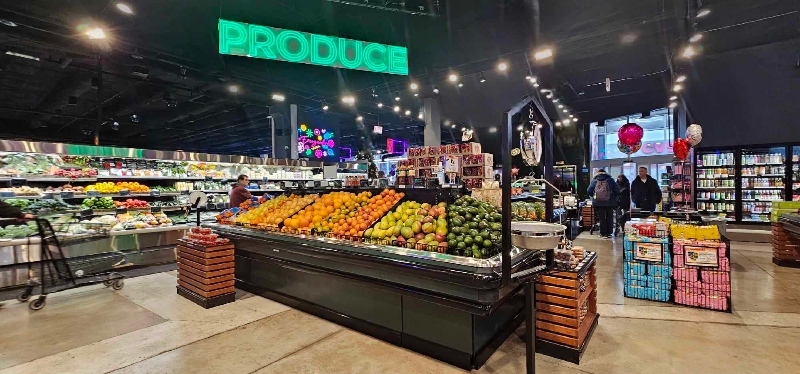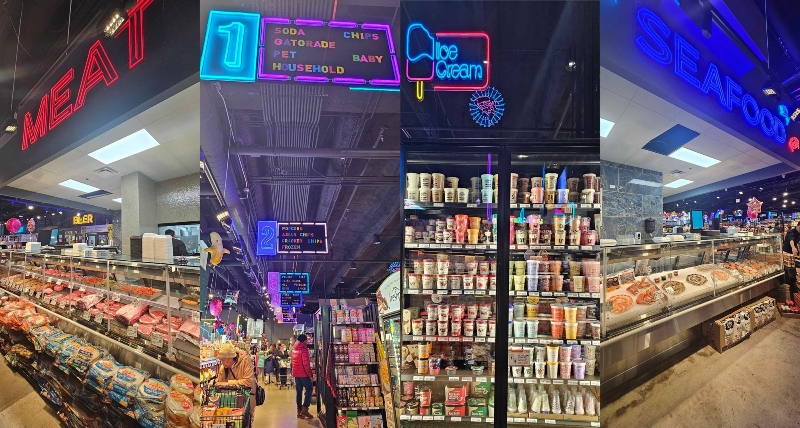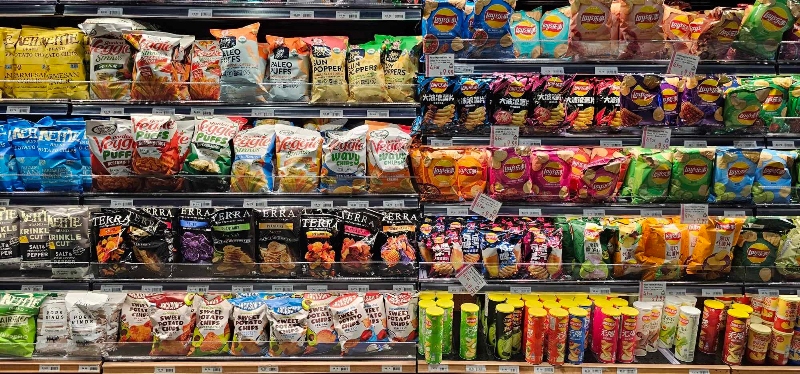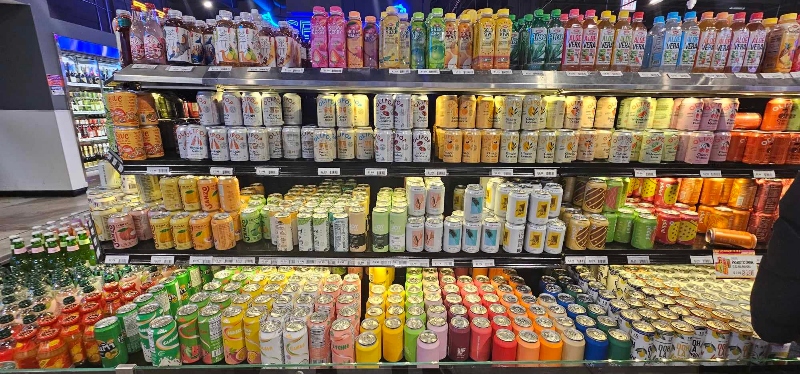East Meets Midwest at Chicago’s Gangnam Market
Gangnam Market, Chicago’s highly anticipated “American-Asian hybrid” grocery store, fully opened its doors in early December – bringing with it a full supermarket, food court, and bar to the city’s River West neighborhood. Named after the same South Korean district that garnered worldwide recognition from the hit song, “Gangnam Style”, the retailer took over the 28,000 square foot space at 1001 W. Chicago Ave that was previously occupied by the short-lived Urban Market, an independent grocer that only stayed open for a year amid supply chain issues and technical hiccups.

Photo Credit: McMillanDoolittle
The first-of-its-kind supermarket is the brainchild of local restauranteur Kenny Yang, the owner of the Strings Ramen chain, Ken Kee restaurant in Chinatown, and Gyuro Ramen in the West Loop. Adorned with vibrant, eye-catching neon signs throughout the space and music from K-pop bands like Blackpink playing overhead, Gangnam Market marks Yang’s first foray into grocery and brings a unique international flair to the Chicago grocery landscape.

Photo Credit: McMillanDoolittle
What makes Gangnam Market different than other local Asian grocery competitors like Hmart, 88 Marketplace, and Joong Boo Market? Unlike these competitors who offer predominantly Asian groceries and only sell a limited number of American products, Gangnam Market takes a more balanced approach to its product assortment. Brands that you would find at Whole Foods or Jewel-Osco – think leading natural brands like Simple Mills and Lesser Evil as well as mainstream leaders such as Cheez-It and Triscuit – can be found alongside green tea Oreos and spicy crab flavored Lay’s potato chips. Gangnam Market is a place where you could buy much of your conventional grocery shopping haul in addition to recipe-specific ingredients for Asian-inspired dishes and snacking. This is a contrast to traditional ethnic markets where you can find Asian ingredients but might need to supplement by shopping elsewhere for conventional American groceries. Kenny Yang’s industry knowledge and ties to the food scene also shine through with the presence of trending brands like Asian-inspired ice cream up-and-comer Kurimu and David Chang’s Momofuku product line.

Photo Credit: McMillanDoolittle
The grocery section of Gangnam Market offers a mixture of American and Asian staples, with a product lineup that mirrors what you could find at a traditional supermarket but with more of an Asian flair. The fresh departments, like the meat and seafood counters, lean more American from a variety standpoint – but what Gangnam Market might lack in global options along the store perimeter, it makes up for with the diverse range of dining options available in its food court. The restaurant side of the store includes a full-service bar, bubble tea counter, and six food court vendors offering a destination for pan-Asian cuisine. The eclectic array of fast-casual options includes Korean tacos, Hainanese chicken rice, Hong Kong-style bakery items, the nation’s first turkey ramen, sushi, and more.
The hybrid blend of grocery variety and the clean, vibrant aesthetic provides an approachable place for Chicagoans to shop and dine. The two-in-one combination of restaurant and grocery not only gives Zillennial foodies the opportunity to order new dishes to try but also purchase ingredients to experiment with cooking Asian cuisine at home. This may be more appealing to those less familiar with navigating traditional Asian supermarkets whose sights and smells can be a bit intimidating for the unindoctrinated.

Photo Credit: McMillanDoolittle
Ownership has taken a phased approach to opening Gangnam Market. The supermarket portion was soft launched earlier in the year, the store hosted its grand opening in early December with the introduction of its food court and bar, and exterior signage is expected to be installed at a later date. I was a bit perplexed that street signage had not been installed yet at the grand opening weekend, but launching in phases still allows the retailer to drive sales, rather than delaying opening until the operation is 100% ready and earning zero income up until that point. This approach also gives guests a reason to return and see what new changes have been deployed since they last visited the store. In addition to a new store sign, perhaps of the neon variety, we look forward to seeing what else is to come from Kenny Yang’s addition to Chicago’s grocery scene.
Interested in learning more about the latest in food and grocery innovation? Check out McMillanDoolittle’s recent coverage of McDonald’s first-of-its-kind CosMc’s beverage concept and Wegmans’ debut in Manhattan.

No Comments